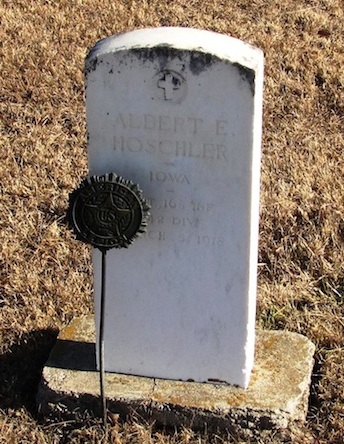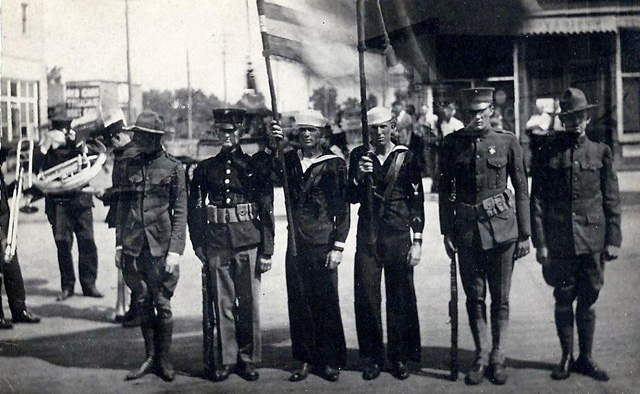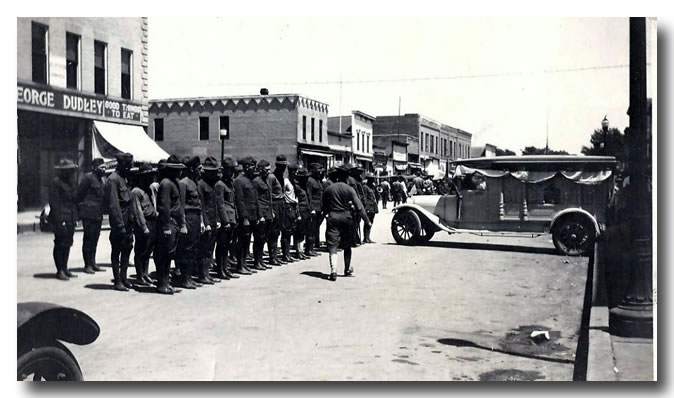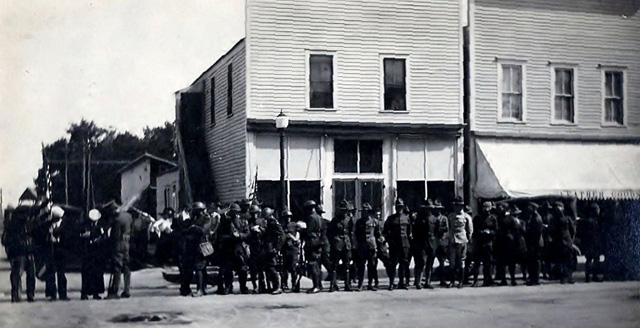Akron Register-Tribune
Thursday, August 11, 1921
REMAINS OF WAR HERO LAID TO REST IN NATIVE SOIL
The remains of Pvt. Albert E. Hoschler, the first Akron boy to enlist for service in the World War and the first Akron boy to be killed in battle on the field of France, arrived here Saturday, Private DeRitter, of Des Moines, acting as military escort.
It was arranged that burial take place Tuesday, with full military honors, in charge of the local American Legion Post which bears his name. At 9:30 a.m. members of Albert E. Hoschler Post and Auxiliary assembled at the municipal flagpole and marched to the Klauer Bros. undertaking parlors, at which place the motor hearse bearing the soldier’s remains was in waiting. Headed by the Hawarden bank, playing a solemn dirge, the cortege moved to St. Patrick’s Catholic church, where the funeral service started at 10 o’clock. Soon after the flag-draped and flower laden casket was taken to its place in front of the altar, the church was filled to its capacity and nearly as many more stood outside the edifice. The solemn and impressive mass was celebrated by the pastor, Father Francis Wrenn, assisted by Father Sweeney, of Manson, Iowa, the two latter having been U.S. Army chaplains. Father D. K. Hurley, of Anthon, Iowa, formerly pastor here, and Father Bradley, of Hawarden, were also present, but Father Veit, of Grand Junction, was unavoidably detained from coming. At the close of the mass, Father Wrenn delivered a splendid patriotic sermon, in which he paid high tribute to the American soldiers who served in the World War and to the memory of Pvt. Albert E. Hoschler, who made the supreme sacrifice in upholding a great cause. He also spoke of the fine testimonial to the life and character of Pvt. Hoschler given him by Father Hurley, who was the young man’s pastor here for a number of years. As the choir sang, “America,” the congregation arose and filed out of the church. The following Legion men acted as ushers in the church: Ralph Gale, P. A. Foley, George Bray and Vincent Conway.
After the Hawarden band had played, “Nearer My God To Thee,” the procession again formed and proceeded to the Catholic cemetery, the Legion men, in uniform marching the entire distance from the church to the cemetery. Heading the procession were the color bearers, Earl Lias and Thos. Meredith and the color guard, Ed Wilkens and Wayne Vargason. Then came members of Hoschler Post, Hawarden and LeMars and Merrill Posts to the number of nearly a hundred. The pallbearers were Philip Wahl, Frank Brunker, Wm. Halverson, James Gleason, Earl Gale and J. N. Lamoureux.
Following the hearse came the mourners and clergymen in autos and a long line of autos carrying several hundred friends to the beautiful city of the dead. As the head of the procession reached the cemetery gate, the Hawarden band was in waiting and played a march, leading to the place of the burial. There the brief but impressive burial service of the American Legion was conducted by Post Commander L. L. Burrill assisted by his comrades.
The clergymen offered prayer and Chaplain Smith gave a short but intensely patriotic and touching address. As the casket containing the remains of Pvt. Hoschler was lowered to its final resting place in his native soil, the Legion firing squad gave its parting volley. Just before “Taps” was sounded by Bugler Alva Bellwood, the three local veterans of the Civil War—O.A. Stoel, W.A. Neal and E. Spittle—stepped to the head of the grave, reverently uncovered and gave the military salute in honor of the young soldier who so valiantly had given his life in his country’s cause. The firing squad, in charge of Russell Pollock, was comprised of Velton Barr, Ernest Engleman, Eric Johnson, Victor Neal, Lee Stoutenberg, Albert Drew, J. E. Waterman and George Mohlman.
As a mark of respect, all Akron business places closed during the funeral, from 10 a.m. until noon.
Sgt. Strouse, of LeMars, one of the old Co. K men and later of the famous 168th Infantry, attended the burial of Pvt. Hoschler at Baccarat, France, and was present at his military funeral and burial here Tuesday. This considered rather an unusual circumstance.
-----
In the Register-Tribune’s issue of March 14, 1918, was chronicled the death of Pvt. Albert E. Hoscher, from which the following extracts are taken:
This community was plunged into a deep sorrow Saturday evening when a message was received conveying the word that Private Albert E. Hoschler, son of Mrs. Bertha Hoschler of this city, had been killed in action with the American forces in France on March 5th, 1918. Akron thus sustains its first casualty shock of the great European war, and the true nature of the terrible conflict waging across the sea is brought very close home to our people. While the blow falls heaviest upon the mother, sisters and brothers of this gallant soldier boy who gave his life so willingly and freely for his country and the great cause of world democracy, yet there comes to each of us a deep sense of personal loss in the knowledge that he will never return to his home and friends. Definite details as to just how he met his death are, of course, lacking at this time, but the press dispatches of Saturday noted a strong German offensive upon the American sector in Lorraine on the 5th. The German raid was repulsed, but it was given out that quite a number of American soldiers were killed and wounded. The casualty list later given out included the names of fifteen Iowa soldiers in the 168th Infantry.
Albert E. Hoschler, third son of Mrs. Bertha Hoschler, was born near Genesee, Idaho, July 20, 1898, and came to Akron vicinity with his parents when he was about nine years of age. For a couple of years previous to his enlistment, he was employed in Hitzeman Bros. Barber shop in this city and became proficient at the trade. On March 29, 1917, Sergeant Bowers and Corporal Eilers came over from LeMars to interest Akron young men in enlisting in Co. K, Second Iowa infantry, of LeMars, and Albert Hoschler is said to have been the first to sign their application here. He, with seven other Akron men—Lester Stinton, Philip Maxson, Otto Post, Gilbert Mahood, Carl Barr (later killed in action), Eric NyBlom and Albert E. Lipp—passed the examination and enlisted in Co. K at LeMars on April 9, 1917. They went there for weekly drills until the 1st of July, 1917, when Camp Faber was established at LeMars and the soldiers went into training there. They remained there until Camp Faber was discontinued and the men separated and sent to different national cantonments. Private Hoschler was among those who left for Des Moines on August 20, 1917, where he was assigned to the Third Iowa infantry and soon went to Camp Mills, Hempstead, N.Y. The Third Iowa was there consolidated with the 168th United States Infantry, 84th Brigade, 42nd Division, which became known as the Rainbow Division—the first contingent of the National army to leave this country and land in France for active war service.
Private Hoschler was assigned to service in the telephone corps of headquarters company of the 168th at Camp Mills. He was on the big U. S. transport that left New York on October 18th and after being out two or three days was compelled to return to port because of trouble with the ship’s machinery, rumored to have been the work of enemy spies. He made the trip across to France shortly after that time and had since been in the service of his country there. Private Hoschler was not quite 19 years of age when he volunteered his services, but the true spirit of patriotism was so developed far beyond his years, and answered his country’s call in time of greatest need.
Albert Hoschler was a young man of exceptionally fine characteristics and was universally liked. He was quiet and reserved and his habits were most exemplary. He was ambitious to make something of himself above the ordinary. To show his thoughtful and generous nature, it is told of him that after he enlisted he made it a point to accept all the tobacco apportioned to him, although he did not use it in any form; but he stored it away in his effects with the idea of parceling it out to his needy comrades in the future.
To the grief-stricken mother, four sisters and three brothers, there goes
out the deepest sympathy of the community; yet there comes to all a degree
of consolation in the fact that Akron’s first soldier boy to make the
supreme sacrifice passed out while fighting the good fight for human
liberty, even though he may be one of the hundreds of thousands of uncrowned
heroes of the Great War for Humanity. The memory of Albert E. Hoschler will
ever be enshrined in the hearts of his friends and countrymen, and in
far-off France he realized a worthy boyhood ambition to make something of
himself above the ordinary in this life.
Due honor will be accorded Akron’s first soldier dead in this war, as
announced elsewhere in this issue, by a Requiem High Mass in Memoriam at the
Church of St. Patrick next Monday, March 18, at 10 a.m. By proclamation of
the Mayor and Council, all business places are requested to close from 10
a.m. until noon of that day as a mark of public respect.
-----
From a handsome volume, “The Price of Our Heritage,” published by Chaplain Winfred E. Robb, of Des Moines, in memory of the heroic dead of the 168th Infantry, is gleaned the fact that Albert E. Hoschler, Private Headquarters Company, was killed March 5, 1918, while serving with the Stokes Mortar Platoon, which were manning gun No. 1 in the first encounter with the enemy on the Lorraine sector, when a German 210 struck directly beneath the gun and killed all the crew instantly. Private Hoschler’s body, although badly mutilated, was found and buried with military honors at Baccarat, France. His six comrades killed by the same shell were: Pvt. Edward Nash, of Kingsley, Ia.; Pvt. Clifford C. Worden, of Mason City, Ia.; Pvt. Glenn Pederson, of Spencer, Ia.; Cpl. Dean Parish, of Glade Valley, N.C.; Sgt. James E. Wedding, of Webster City, Ia.; and Sgt. Walter J. Porsch, of Fort Dodge, Ia,, the latter having been a nephew of Thos. Stinton of this city.
In Chaplain Robb’s volume, under the title, “Our First ‘Hitch’ Up in Lorraine,” is given the following graphic account of the fatal action:
On March 4, at 4:30 o’clock in the morning, with a sudden roar their artillery and trench mortars began the artillery preparation for the raid. They tore our trenches literally to pieces on the left one-half of our sector, occupied by Company B, of Des Moines, and Company D, of Centerville, with the Machine Gun company, of Des Moines, supporting them, while the Stokes Mortar platoon was of Headquarters company. Companies A and C were in the second line in support. For one hour and thirty-three minutes the roar of shells of both the enemy and our own literally shook the earth. Then the raiders came over, but so well were our troop supported by their artillery and machine guns and so splendidly and heroically did they fight, that only once did the raiders of the Eleventh Bavarians get into our trenches, and these were cleared out of our trenches with scant ceremony. Eighteen of our men were killed and some thirty-eight were wounded in this raid, but not one was captured. For their steadiness under fire and the way in which they fought in repulsing the attack, they were honored by the French Corps by three different platoons being give citations and awarded the Croix de Guerre.
CARD OF THANKS
We wish to express our sincere appreciation for the many kindnesses and sympathy shown by friends and particularly by the American Legion and Auxiliary members upon the occasion of the funeral and burial of our beloved son and brother, Albert E. Hoschler; also for the beautiful floral offerings.—Mrs. Bertha Hoschler and Family.

Tombstone in St. Patrick's Catholic Cemetery, Akron, IA
Return to Albert E. Hoschler World War I photo page
~Photos and information submitted by family descendant, Kim Callahan
~Newspaper research contributed by this county site coordinator, Linda Ziemann


